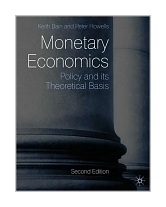|
||
• wydawnictwa polskie
• Zamów informacje o nowościach z wybranego tematu • kontakt
• Cookies na stronie |
MONETARY ECONOMICS POLICY AND ITS THEORETICAL BASISBAIN K. HOWELLS P.wydawnictwo: PALGRAVE MACMILLAN , rok wydania 2009, wydanie IIcena netto: This fully revised second edition of Bain and Howells' Monetary Economics provides an
up-to-date examination of monetary policy as it is practised and the theory underlying it.
The authors link the conduct of monetary policy to the IS/PC/MR model and extend this
further through the addition of a simple model of the banking sector. They demonstrate why
monetary policy is central to the management of a modern economy, showing how it might
have lasting effects on real variables, and look at how the current economic crisis has
weakened the ability of policymakers to influence aggregate demand through the
structure of interest rates.
KEITH BAIN was Principal Lecturer in Economics at the University
of East London, UK. He taught on a number of modules including Monetary Economics,
Economic Policy and Finance and the Economy. Table of Contents The Meaning of Money 502 pages , Paperback Księgarnia nie działa. Nie odpowiadamy na pytania i nie realizujemy zamówien. Do odwolania !. |


